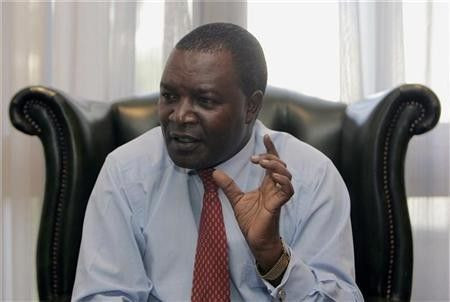Kenya almost-doubles inflation target to 9 pct

Kenya's central bank changed another key policy aim by almost-doubling this fiscal year's inflation target to 9 percent, just weeks after being driven to make a huge rate rise to combat soaring inflation and save the plunging shilling.
Tuesday's unveiling of the new target, for the year running July to June, followed months of trenchant criticism of the bank for not taking aggressive action to stop the shilling's slide on the back of double-digit inflation and a yawning balance of payments gap.
At the height of the crisis last month the shilling was down more than 25 percent against the dollar this year with some investors unwilling to hold it.
The bank vowed on Tuesday that achieving price stability was its main goal, further underscoring its commitment to fighting inflation and extreme volatility in the exchange rate, ahead of a general election next year. Its inflation target for the year had been 5 percent.
Kenya's year-on-year inflation rate rose to 18.91 percent in October from 17.32 percent a month earlier as food, electricity and fuel prices all went up.
In pursuit of this objective, the bank formulates and conducts monetary policy to contain overall inflation at the government target of 9 percent for 2011/12 financial year with a deviation of 2 percentage points on either side, Governor Njuguna Ndung'u said in the bank's October newsletter.
Analysts said the bank had little choice but to raise the target after sustained pressure on prices of food and energy, as well as the credibility gap created by the earlier widely held view in the market that central bank was only pre-occupied by economic growth and was flat-footed by inflation.
It is really just a reflection of the problems faced by the CBK. Certainly, external or supply side shocks have had a great impact on inflation, and this was beyond the control of the MPC (monetary policy committee), said Leon Myburgh, sub-Sahara Africa strategist at Citi in Johannesburg.
Adjusting the target to 9 percent probably also reflects that the MPC was behind the curve and the high inflation is not only a function of supply side measures, but also a policy rate that was too low, and adjusted too late.
Policymakers raised the central bank lending rate by an unprecedented 550 basis points to 16.5 percent at the start of this month to counter rampant inflation and exchange rate volatility.
Analysts conceded that the change in target was more realistic as it took into account prevailing conditions at home and abroad.
With CPI set to rise further in the near term because of recent fuel price increases, committing to a target of 5 percent at this stage is simply unrealistic, said Razia Khan, head of Africa research at Standard Chartered in London.
Nonetheless, the amended target of 9 percent underscores the CBK's ongoing commitment to price stability.
SHOCKS
Ndung'u said that in the recent past, supply-side shocks arising from both international and domestic market developments had led to price volatility.
These developments continue to affect the economy and have dampened the recovery from the adverse effects of the global financial crisis, he said.
It is worth noting that unlike in the previous economic shocks, the current shocks have persisted for over 11 months.
A Reuters poll showed earlier in the week that Kenya's economy was likely to grow 4.8 percent this year and 5.0 percent in 2012 on improved rains and a rise in exports, but that trade could be hit again by a slump in demand in its main trading partner Europe. .
The planning minister expects the economy to grow by 4 percent this year from a previous 4.2-4.5 percent, while the International Monetary Fund sees the economy growing by 5.0 percent from its earlier 5.3 percent forecast for 2011.
The next meeting of central bank's rate-setting committee is scheduled for December 1. Among the factors that the committee is expected to consider while making their decision is the fact that the shilling has strengthened this month, as lending rates soared in line with the tightening cycle.
The shilling has rallied in recent days and hit 89.40/70 on Tuesday, levels last seen in mid-July and 1.4 percent up on Monday's close of 90.75/90.95. It traded at an intra-day high of 89.65, Thomson Reuters data showed.
The shilling is 16 percent firmer than the dollar from its all-time low of 107 it hit in October, but is still some 9.9 percent weaker in the year to date.
We only expect inflation to fall into the 9 percent (+/- 2 percentage points) or 7-11 percent region that the central bank is now targeting, in the fourth quarter of this fiscal year, which is April-June 2012. So that target, in our view, is achievable for only a fraction of the year, Khan said.
Still, some analysts argued that the new inflation target should not be maintained permanently.
At 9 percent the target is relatively high when compared to Kenya's trading partners. The original 5 percent target is more in line with where it should be, so one hopes that the higher target is only a temporary measure, said Citi's Myburgh.
Of all the policy changes the central bank has made this year to support the shilling and fight inflation, the most drastic has been the steep rise in the central bank rate, which now stands at 16.50 percent from 5.75 percent at the start of the year.
© Copyright Thomson Reuters 2024. All rights reserved.





















